
A coast guard or coastguard is a maritime security organization of a particular country. The term embraces wide range of responsibilities in different countries, from being a heavily armed military force with customs and security duties to being a volunteer organization tasked with search and rescue without law enforcement authority. In most countries, a typical coast guard's functions are distinct from those of the navy and the transit police, while in certain countries they have similarities to both.

A patrol boat is a relatively small naval vessel generally designed for coastal defence, border security, or law enforcement. There are many designs for patrol boats, and they generally range in size. They may be operated by a nation's navy, coast guard, police, or customs, and may be intended for marine, estuarine, or river environments.
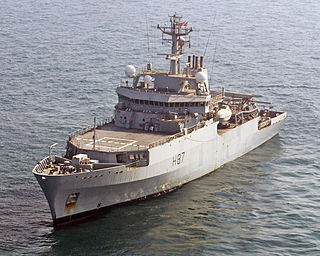
HMS Echo was the first of two multi-role hydrographic survey ships commissioned by the Royal Navy. With her sister ship, HMS Enterprise, they formed the Echo class of survey vessels. She was built by Appledore Shipbuilders in Devon in 2002 and was the ninth Royal Navy vessel to carry the name. She was retired from service in 2022.
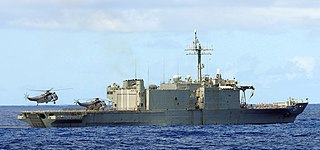
HMAS Kanimbla was a Kanimbla-class landing platform amphibious ship operated by the Royal Australian Navy (RAN). Originally built for the United States Navy (USN) as the Newport-class tank landing shipUSS Saginaw (LST-1188), the ship was decommissioned in 1994 and sold to the RAN.

The Kanimbla class was a class of amphibious transport ships operated by the Royal Australian Navy (RAN). Two ships were purchased by Australia in 1994 and modified. Problems during the handover process and the need to repair previously unidentified defects meant the ships did not enter operational service until the end of the decade.
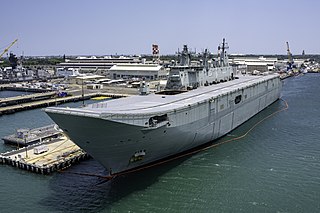
The Canberra class is a ship class of two landing helicopter dock (LHD) ships built for the Royal Australian Navy (RAN). Planning to upgrade the navy's amphibious fleet began in 2000, based on Australian experiences leading the International Force for East Timor peacekeeping operation. With a new climate for growing Australian Navy spending, a desire existed for forward defence capability for landing and supporting troops on Asian territory, that had never existed in Australian history, even with the old Majestic-class light fleet carriers, HMAS Melbourne and HMAS Sydney in the 1970s. In 2004, French company Direction des Constructions Navales (DCN) and Spanish company Navantia were invited to tender proposals, with DCN offering the Mistral-class amphibious assault ship and Navantia proposing the "Buque de Proyección Estratégica" design. The Spanish design was selected in 2007, with Navantia responsible for construction of the ships from the keel to the flight deck, and BAE Systems Australia handling the fabrication of the combat and communications systems. Finally, Siemens (Germany) supplied and fitted the azimuth thrusters.
The Australian Patrol Boat Group is a Force Element Group (FEG) of the Royal Australian Navy. It manages the Navy's patrol boats.

The Protector-class offshore patrol vessel is a ship class of two offshore patrol vessel (OPVs) operated by the Royal New Zealand Navy (RNZN) since 2010. The ships are named HMNZS Otago and HMNZS Wellington.

The Bay class is a class of eight armed patrol boats, built by Austal and used by the Customs Marine Unit of the Australian Customs and Border Protection Service. They entered service during the late 1990s and early 2000s, and are primarily used on border protection duties.

The Marine Unit, formerly the Australian Customs Service National Marine Unit, is a division of the Australian Border Force which acts as a Coast Guard in guarding Australia's coast. The Marine Unit focuses on surveillance and response activities within the Australian Economic Exclusion Zone, and the operation and training of ships and crews to do so.

The MV Oceanic Viking was an armed patrol vessel of the Australian Customs Service. Originally built in 1996 as the offshore supply vessel Viking Lady for Norwegian shipping company Eidesvik Shipping AS, the ship was converted into a cable layer in 2000 and renamed Oceanic Viking. The ship was chartered to the Australian Customs Service through P&O Marine Services from 2004 to 2010. In 2011, it was purchased by A&P Tyne, Isle of Man, and renamed European Supporter.
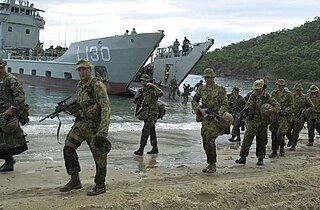
The Royal Australian Navy and Australian Army have operated 29 amphibious warfare ships. These ships have been used to transport Army units and supplies during exercises and operational deployments.

Australian Defence Vessel (ADV) Ocean Protector is an auxiliary naval vessel of the Royal Australian Navy manned and managed by Teekay.

The Cape class is a ship class of 22 large patrol boats operated by the Marine Unit of the Australian Border Force, the Royal Australian Navy (RAN) and the Trinidad and Tobago Coast Guard. Ordered in 2011, the vessels were built by Austal to replace Customs' Bay-class patrol boats, and entered service from 2013 onwards. Following availability issues with the Armidale class, two vessels were chartered by the RAN from mid-2015 to late 2016. A further two vessels were ordered at the end of 2015 by the National Australia Bank, who will charter the patrol boats to the Department of Defence from completion in 2017. 2 vessels were ordered by Trinidad and Tobago for their coast guard in 2018 with the vessels delivered in 2021. The RAN placed an order for six 'Evolved' Cape-class vessels in 2020, a second order in 2022 for an additional two vessels, and a third order in 2023 for a further two vessels.

The disappearance of Malaysia Airlines Flight 370, a scheduled international passenger flight from Kuala Lumpur International Airport to Beijing Capital International Airport on 8 March 2014, prompted a large, multinational search in Asia and the southern Indian Ocean that became the most expensive search in aviation history. Analysis of communications between the aircraft and Inmarsat by multiple agencies has concluded that the flight ended in the southern Indian Ocean.
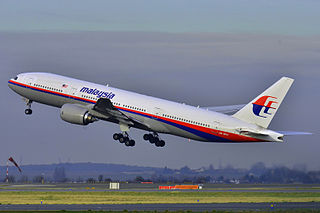
The timeline of Malaysia Airlines Flight 370 lists events associated with the disappearance of Malaysia Airlines Flight 370—a scheduled, commercial flight operated by Malaysia Airlines from Kuala Lumpur International Airport to Beijing Capital International Airport on 8 March 2014 with 227 passengers and 12 crew. Air traffic control lost contact with Flight 370 less than an hour into the flight, after which it was tracked by military radar crossing the Malay Peninsula and was last located over the Andaman Sea. Analysis of automated communications between the aircraft and a satellite communications network has determined that the aircraft flew into the southern Indian Ocean, before communication ended shortly after 08:19 (UTC+8:00). The disappearance initiated a multi-national search effort that became the most expensive search in aviation history.
Two ships have been named Skandi Bergen:
TechnipFMC plc is a French-American, UK-domiciled global oil and gas company that provides services for the energy industry. The company was formed by the merger of FMC Technologies of the United States and Technip of France that was announced in 2016 and completed in 2017.
The ABFC Thaiyak is a patrol vessel used by the Customs Marine Unit of the Australian Border Force, primarily stationed at the Ashmore and Cartier Islands and is also known as the Long Term Ashmore Capability (LTAC) vessel. Its name, meaning spear, is based on suggestions from Torres Strait Islander crew members who had consulted with their elders.

















